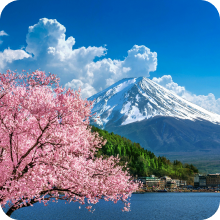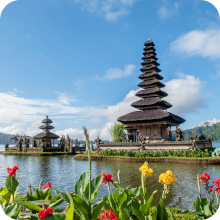A Comprehensive Guide to Holidaying in Japan
Ah, Japan. Land of sushi, sumo, samurai, and, well, more incredibly distinctive things starting with 's' than any other place I've ever visited. But if I started rattling off the wonders of Japan right at the outset, we'd never get to the end of this article, and you wouldn't know where to start with your holiday planning. So, dear reader, buckle up, because we're about to go on a metaphorical bullet train ride through the intricacies of a Japanese holiday.
Japan is an entrancing blend of traditional and ultra-modern, of serene temples nestled amidst skyscrapers. It’s where ancient rituals rub shoulders with cutting-edge technology, and the natural beauty can leave you breathless. One moment, you're standing amid cherry blossom trees in full bloom, the next, you're staring up at a 40-story electronic Godzilla atop a Shinjuku skyscraper. And that's just Tuesday.
Table of Contents
- The Best Time to Visit Japan
- Essential Preparations for Your Japan Holiday
- Passport and Visa Requirements
- Language Basics and Cultural Etiquette
- The Importance of Staying Connected: Necessity of a Travel SIM Card
- Choosing the Right Travel SIM Card for Japan
- Benefits of Using a Travel SIM Card in Japan
- Top Travel SIM Cards for Japan
- How to Buy and Activate Your Japan Travel SIM Card
- Japan Itinerary Highlights: Where to Go and What to See
- Unveiling the Urban Charms: Tokyo, Kyoto, and Osaka
- Venturing Beyond the Cities: Mt. Fuji, Hiroshima, and Hokkaido
- Travel SIM Card at Work: Augmenting Your Experience
- FAQs: Quick Answers for Your Burning Japan Travel Questions
With such a diverse offering, it's no surprise that Japan attracts millions of visitors each year. Whether you're a culture vulture, a gastronomic adventurer, a tech-obsessed otaku, or someone who appreciates the subtle art of Zen, Japan has something in store for you.
But, to make the most of your holiday in Japan, you'll need to come equipped with more than just an adventurous spirit and a fully-charged camera. A good deal of preparation is essential to ensure that your trip goes as smoothly as the famed Japanese shinkansen.
And part of this preparation, believe it or not, involves getting yourself a travel SIM card. "A SIM card?" I hear you say, "Why, oh wise travel guru, would I need a travel SIM card?" Well, dear reader, think of it this way: would you go on a road trip without a roadmap, or more pertinently, a GPS? I thought not. Similarly, a travel SIM card is your digital compass in the bustling cityscapes and serene countryside of Japan, connecting you to the internet, helping you navigate, translate, and even order that delectable bowl of ramen at the restaurant with no English menu. But more on that later.
So, as you've probably guessed, I've got a lot to share. Whether it's essential preparation tips, SIM card wisdom, or introducing you to the culinary delights of Nihon, this guide will help you prepare for your Japanese holiday like a seasoned pro. So grab yourself a cup of green tea and get comfortable - your journey to the Land of the Rising Sun starts here!
The Best Time to Visit Japan
Like choosing between Ramen or Sushi, deciding when to visit Japan can be a bewildering decision. The country dazzles in all seasons, each painting the landscape with its unique charm. Let's embark on a whirlwind tour of Japan's calendar and find out when your inner wanderer should pack its bags.
Seasonal Highlights in Japan
Japan's year is a wheel of beauty that spins through the vibrant hues of four distinct seasons.
Spring (March to May) is arguably the best time to visit Japan, with the country in the throes of the famous sakura (cherry blossom) season. During Hanami, or cherry blossom viewing, people picnic under the transient beauty of these blush-tinted blooms, an experience as quintessentially Japanese as bowing or bathing in onsens. Cities like Kyoto and Tokyo transform into blushing brides, and trust me when I say it's something that needs to be seen to be believed.
Summer (June to August) in Japan can be hot and humid, but don't let that deter you. There's the spectacular fireworks (Hanabi) festivals, the Bon Odori dances, and summer-exclusive delicacies like kakigori (shaved ice) to relish. Just remember to keep that travel SIM card handy to check up-to-date weather forecasts and find the nearest air-conditioned Pokémon Centre.
Autumn (September to November) in Japan is like stepping into an artist's palette. The koyo (autumn leaf viewing) season drapes the country in vivid oranges, yellows, and reds, offering an equally enchanting but less crowded alternative to the spring sakura season. This is the season to hike the mountains of Hakone or Nikko, fueled by Japan's autumn speciality, roasted sweet potatoes.
Winter (December to February) showcases Japan in a new light, quite literally. The Sapporo Snow Festival in Hokkaido is a spectacle worth braving the cold for, featuring enormous ice sculptures that can give Elsa from Frozen a run for her money. Onsen (hot spring) resorts gain popularity, offering you the chance to bathe in outdoor hot springs while snowflakes gently drift down from the sky.
Important Festivals and Events
Japan's calendar is peppered with numerous festivals, or matsuri. Here are a few highlights, but remember, events can sometimes change dates faster than a Tokyo fashion trend. So, keep your travel SIM card close and your internet closer:
- Hanami (Cherry Blossom Festival): Late March to Early April
- Gion Matsuri (Kyoto's most famous festival): All through July
- Awa Odori (dance festival in Tokushima): 12th-15th August
- Koyo (Autumn leaf viewing): Late October to Early December
- Sapporo Snow Festival: Early February
The point being, no matter when you visit, Japan is always ready to astonish you with its scenic beauty and cultural offerings. But as they say, timing is everything, especially when you're trying to avoid a selfie stick battle during the cherry blossom season.
So pack accordingly and remember, in the immortal words of Bill Nye, "Everyone you will ever meet knows something you don't." And that something might just be the best local tip for your holiday in Japan!
Essential Preparations for Your Japan Holiday
Just like Mr. Miyagi preparing Daniel-san for the Karate championship in the original "Karate Kid", we need to prepare diligently for our Japanese adventure. This doesn't involve any "wax on, wax off" shenanigans, but there are a few important things to consider.
Passport and Visa Requirements
As of my last knowledge update in September 2021, citizens from 68 countries, including the US, UK, Canada, Australia, and most of the EU, can enter Japan for up to 90 days without a visa. However, as I always say, "when it comes to visas, assume nothing!" Changes can happen quicker than the end of an anime series, so it's wise to check the latest information from your nearest Japanese Embassy or Consulate before you travel.
Language Basics and Cultural Etiquette
It's no secret that Japan loves its traditions and etiquettes, as much as Hollywood loves rebooting the Spider-Man series. Taking the time to learn a few basic phrases and understanding local customs will endear you to the locals faster than you can say "Arigato!"
Some phrases to get you started:
- "Konnichiwa" (Good day)
- "Arigato" (Thank you)
- "Sumimasen" (Excuse me / I'm sorry)
Also, remember that in Japan, it's common to bow when greeting, apologizing, or thanking someone. When in doubt, follow the old saying, "When in Rome, do as the Romans do." Except, you know, you're in Japan, not Rome.
The Importance of Staying Connected: Necessity of a Travel SIM Card
In this digital age, exploring a foreign land without an internet connection is akin to being in a "Game of Thrones" episode without dragons—possible, but why would you want to do it?
Having a travel SIM card ensures that you have a lifeline to the digital world, whether it's translating complicated Kanji script on a menu, navigating Tokyo's labyrinthine metro system, or finding out when the next sumo wrestling match takes place.
Plus, it means you can share those Instagram-perfect moments in real time, because if a sushi roll is eaten in Japan and no one is around to see it on social media, did it really happen?
In our next section, we'll dive deeper into the world of Travel SIM cards, from choosing the right one to activating it. So hang tight, because the journey through the 'SIM'ple world of Travel SIM cards is about to get real!
Choosing the Right Travel SIM Card for Japan
Like choosing a Harry Potter house, picking the right travel SIM card for Japan requires careful consideration (and without the help of the Sorting Hat, alas!). It’s your key to unlocking all the digital magic that can enhance your travel experience, so let’s dive right into it.
Benefits of Using a Travel SIM Card in Japan
Having a local SIM card while you explore the Land of the Rising Sun is like having your own digital wand, casting spells to summon maps, translations, and even food delivery at your behest. It helps you stay connected with loved ones, share your adventures in real-time, and, crucially, avoid exorbitant international roaming charges that could otherwise buy you a lifetime supply of sushi.
Top Travel SIM Cards for Japan
There are a plethora of options to choose from, but here are a few popular ones:
1. SimsDirect Japan Travel SIM Card: Offering lightning-fast 4G data, and the option of 8, 16, or 31-day plans, it's as dependable as Hermione in a crisis.
2. Mobal Japan Unlimited SIM: Perfect for long-term travellers or digital nomads, it offers unlimited data and no contract - an embodiment of freedom!
3. Sakura Mobile Japan Travel SIM: A popular option with flexible data packages, Sakura Mobile SIM cards are like a good haiku - simple, elegant, and to the point.
Remember, always consider your specific needs (like the duration of your trip and how much data you'll need) when choosing a SIM card.
How to Buy and Activate Your Japan Travel SIM Card
Most of these SIM cards can be conveniently purchased online and delivered to your home, hotel, or even picked up at the airport. Activation is typically as simple as inserting the SIM card into your device and following the provided instructions.
But bear in mind, like being accepted to Hogwarts, your phone must be "unlocked" to accept foreign SIM cards. If you're unsure about this, check with your service provider before you travel.
Having the right SIM card will ensure you’re always just a click away from the information you need, whether it's finding out that "Lost in Translation" bar or the nearest spot to enjoy hanami. So choose wisely and remember, in Japan, even the smallest details can make a big difference - much like knowing the difference between sashimi and sushi before you order!

Japan Itinerary Highlights: Where to Go and What to See
Armed with your travel SIM and a yen (get it?) for exploration, you're now ready to delve into Japan's incredible array of sights and experiences. Think of this as your Marauder's Map of the country, guiding you through the must-visit locations and some off-the-beaten-path treasures.
Unveiling the Urban Charms: Tokyo, Kyoto, and Osaka
Tokyo is where tradition and modernity collide in a kaleidoscopic explosion of neon-lit streets, tranquil temples, high-tech arcades, and trendy boutiques. Your Travel SIM will be a lifesaver when navigating the sprawling metropolis. Don't miss the bustling crosswalks of Shibuya, the vibrant nightlife of Roppongi, and the anime wonderland of Akihabara.
Heading west, Kyoto is the heart of traditional Japan. It's a living postcard of ancient temples, sublime gardens, and the elusive geisha. From the golden splendor of Kinkaku-ji to the mesmerizing bamboo grove of Arashiyama, Kyoto is the embodiment of Japan's age-old culture and charm.
Just a bullet train ride away is Osaka, the kitchen of Japan. Foodies, you're in for a treat! From munching on Takoyaki in Dotonbori to exploring the massive food market of Kuromon Ichiba, Osaka is a feast for all senses. And remember, it's not just about the eating, it's about the experience!
Venturing Beyond the Cities: Mt. Fuji, Hiroshima, and Hokkaido
With your Travel SIM in tow, why not venture further afield to marvel at the iconic Mount Fuji? Whether you're hiking up its slopes in summer or admiring it from the Fuji Five Lakes region, this beloved symbol of Japan is sure to leave a lasting impression.
Further west, Hiroshima offers a poignant insight into World War II's catastrophic impact. The Peace Memorial Park and Museum serve as solemn reminders of the horrors of war but also as symbols of hope and resilience. From Hiroshima, you can also take a quick ferry ride to the beautiful island of Miyajima, home to the famous floating Torii Gate.
Finally, Hokkaido, Japan's northernmost island, is a paradise for nature lovers. It's famous for its ski resorts, hot springs, and national parks. And, if you visit in early February, you'll get to witness the mesmerizing sculptures at the Sapporo Snow Festival.
Travel SIM Card at Work: Augmenting Your Experience
Your Travel SIM Card will prove invaluable in enhancing your travel experiences. It can guide you through the labyrinthine streets of Tokyo, help you decipher food menus, book your bullet train tickets, or even navigate you to the best spot for viewing Mount Fuji. Imagine it as your digital tour guide, available 24/7.
So there you have it - an adventure-packed itinerary that balances Japan's ultra-modern cities with its serene landscapes and poignant historical sites. Whether you're bowing to a deer in Nara or crossing Shibuya's famous intersection, every moment in Japan offers a unique and unforgettable experience. As the Japanese proverb goes, "Even a road of thousand miles begins with a single step". So, why wait? Start planning, and let Japan's irresistible charm sweep you off your feet!
Thanks for visiting our blog, are you planing to travel to Japan? Check out our Japan SIM Card.
Before you take off make sure to check with local government of the travel status.
FAQs: Quick Answers for Your Burning Japan Travel Questions
To wrap up our holiday guide to Japan, let's address some common questions travelers often have. Like a quirky Q&A session at a Comic-Con panel, these insights should clear up some uncertainties you might have about journeying through the Land of the Rising Sun.
1. Is Japan Expensive to Visit?
Truth be told, Japan can be as expensive or as economical as you want it to be. The country offers a range of options for different budgets, much like how Netflix caters to different binge-watching tastes. Stay in a traditional ryokan or opt for a budget-friendly capsule hotel, splurge at high-end sushi restaurants or grab a bento box from a local konbini (convenience store). Plan wisely, and your yen will go a long way.
2. Is Japan Safe for Solo Travelers?
If Japan were a superhero, it would probably be Captain America - courteous, disciplined, and incredibly safe. Its crime rates are amongst the lowest in the world. Solo or not, you can navigate Japan with peace of mind, even in the wee hours. Of course, basic precautions are always a good idea, no matter where you travel.
3. Is English Widely Spoken in Japan?
While the level of English proficiency can vary in Japan, major cities like Tokyo and Kyoto are pretty tourist-friendly. Most signs have English translations, and your Travel SIM can easily help you translate more complex conversations. But don't let language barriers deter you. As they say in Star Trek, "Infinite Diversity in Infinite Combinations" - it's the differences that make our experiences richer.
4. What Should I Pack for My Trip to Japan?
Besides your essentials (passport, visa, tickets), do pack a universal power adapter, comfortable shoes for all the walking you'll do, and appropriate clothing for the season of your visit. And of course, don't forget your Travel SIM Card!
5. What's the Best Way to Get Around Japan?
Japan's public transportation system is one of the best in the galaxy. Seriously, even Thanos would be impressed. From the ultra-fast Shinkansen (bullet trains) to efficient metro networks and buses, getting around is relatively straightforward, especially with your Travel SIM aiding in route navigation.
That brings us to the end of our insightful 'Guide to a Holiday in Japan.' Just like the end of a good anime series, it's a little bittersweet, but remember, your adventure is just about to begin. So, buckle up and get ready to create your own "Lost in Translation" moments in the enchanting world of Japan. Sayonara and happy travels!









